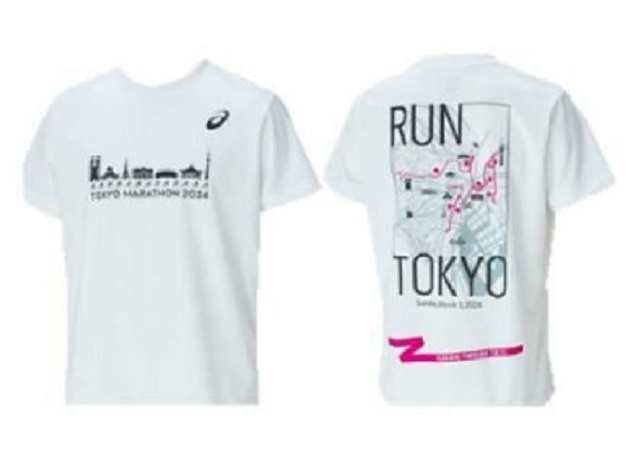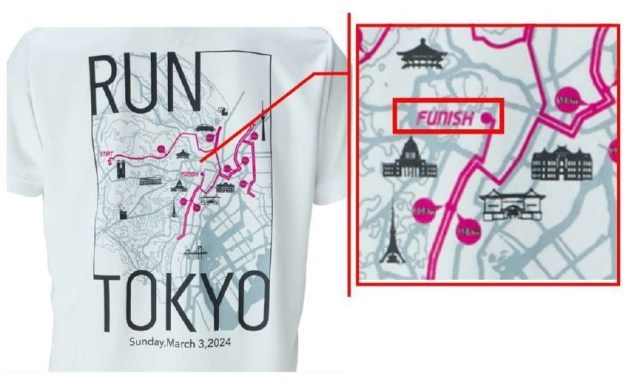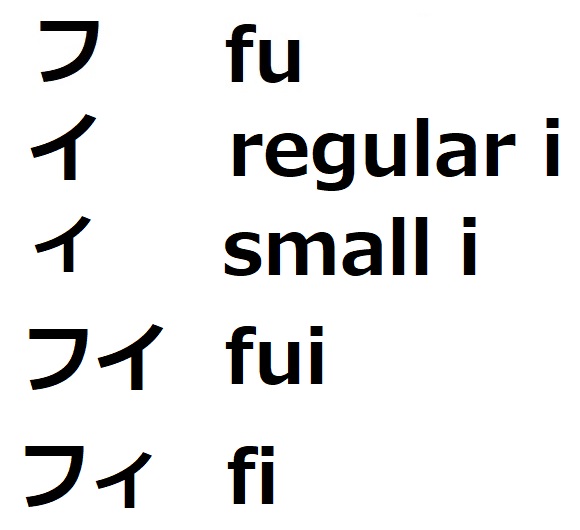
Things started off OK, but didn’t finish quite right.
The Tokyo Marathon was only held for the first time in 2007, but it’s quickly become one of the premier distance running events in Japan. Conditions for this year’s iteration look to be just about ideal, with clear skies and mild temperatures forecast for the start of the race at 9:10 a.m. on Sunday. But while no participants have started running just yet, there’s already been a stumble from sponsor and supplier Asics.
Among other commemorative items, the sportwear company is selling a Tokyo Marathon 2024 Limited-edition Souvenir T-shirt through its online shop and at brick-and-mortar vendors. Available in white, black, or navy blue, the front of the shirt has depictions of some of the famous pieces of Tokyo architecture the runners will go by during the race, and on the back is a map of the course with “RUN TOKYO” written in large lettering.
That’s not the only bit of English text on the shirt, though. The beginning and end of the course are also marked in English, as “START” and…
…”FUNISH.”
Even in a country where the fondness for loanwords often outstrips skill at spelling them, this is a pretty big blunder. The English “finish” shows up frequently in signage, user interfaces, and graphic design in Japan, so it’s surprising to see that funish slipped through to the shirts’ production phase.
So how did this happen? One possibility has to do with the structure of the Japanese language. As we discussed in our explanation of how a sign in Japan mistakenly directed motorists to a fart for 30 years, in the Japanese language consonants generally have to be followed by a vowel. However, much like how Japanese famously doesn’t have an “L” sound, not every consonant/vowel combination we have in English exists in Japanese. Within orthodox Japanese linguistics, the only vowel that F can be followed by is U, which could explain why no one at Asics caught the funish mistake before the shirts were printed and put on sale.
There is a way to brute-force a fi sound when writing Japanese by using katakana, the script used for writing foreign language-sourced words. Even then, though, it involves using the katakana character for “fu” and adding a smaller version of the katakana for “i” immediately after.
However, this “fi” sound isn’t something that technically exists within Japanese pronunciation, and its rendering still contains the character for “fu,” so once again, “funish” might not have immediately jumped out as wrong to Asics’ Japanese staff, including whoever input the text in the design phase.
Then, of course, there’s the non-linguistics-related possible explanation, which is just that I and U are next to each other on a standard keyboard layout, and that funish was just an errant keystroke typo.
Regardless of how it came about, though, Asics has issued an apology for the mistake, saying “We deeply apologize for the trouble caused to our valued customers who purchased the affected items” and offering full refunds, even if the shirts have already been worn, adding “Moving forward, we will be making thorough efforts to improve our quality control, and we ask for your understanding and continued support.”
While it’s definitely an embarrassing mistake for Asics, Twitter reactions have been far from universally negative.
“Funish…ah man, that’s kinda cute.”
“I think they should just go ahead and make the actual banner at the end of the course say funish now.”
“I feel like even a junior high school student would be able to spell finish.”
“I bet someone got royally chewed out for this.”
“I think the designer and Asics person in charge of the project should both get fired.”
“I actually want one of these shirts even more now. It’s like a collector’s item. ‘I hope people think of it like Fun + finish = funish.’”
“It sounds like a mix of ‘fun + run + finish,’ meaning ‘Let’s have a fun run all the way to the end.’ I think this might be a misprint that goes on to become a new buzzword.”
In all fairness, “funish” is exactly the sort of pun-adjacent wordplay that Japan has a major soft spot for, so there’s a good chance that some people who ended up with misprinted shirts will be happy to keep them. For those that want a properly spelled finish to the situation, Asics will provide full refunds through its online return form here.
Source: Asics via IT Media, Twitter
Top image: Asics
Insert images: Asics, SoraNews24
● Want to hear about SoraNews24’s latest articles as soon as they’re published? Follow us on Facebook and Twitter!




 Why Does Engrish Happen in Japan? 30-year-old fart-related signage mistake edition
Why Does Engrish Happen in Japan? 30-year-old fart-related signage mistake edition Japanese park’s English dog turd warning minces no words【Why does Engrish happen?】
Japanese park’s English dog turd warning minces no words【Why does Engrish happen?】 Kanji T-shirt seen on U.S. TV show makes Japanese viewers giggle
Kanji T-shirt seen on U.S. TV show makes Japanese viewers giggle Will wearing 10 McDonald’s Japan coupon T-shirts at once let you earn money for eating Big Macs?
Will wearing 10 McDonald’s Japan coupon T-shirts at once let you earn money for eating Big Macs? Japan considering raising international traveler departure tax even more than previously reported
Japan considering raising international traveler departure tax even more than previously reported Nintendo releases Metroid-shaped ice cube/cooking tray and Samus arm cannon pillow【Pics】
Nintendo releases Metroid-shaped ice cube/cooking tray and Samus arm cannon pillow【Pics】 Is China’s don’t-go-to-Japan warning affecting tourist crowds in Shibuya’s Don Quijote?
Is China’s don’t-go-to-Japan warning affecting tourist crowds in Shibuya’s Don Quijote? Japan’s EF English Proficiency Index rank drops for 11th straight year, hits lowest ever
Japan’s EF English Proficiency Index rank drops for 11th straight year, hits lowest ever I Hate You: Japan’s anime-style mobile romance game starring girls who will never, ever love you
I Hate You: Japan’s anime-style mobile romance game starring girls who will never, ever love you Is the magical Flying Ball that’s trending on Japanese TikTok as easy to use as it looks?
Is the magical Flying Ball that’s trending on Japanese TikTok as easy to use as it looks? Five Okinawan foods that have changed our reporter’s view on local cuisine forever
Five Okinawan foods that have changed our reporter’s view on local cuisine forever Godzilla-shaped ice cream on sale in Tokyo near the sight his most adorable rampage
Godzilla-shaped ice cream on sale in Tokyo near the sight his most adorable rampage I had no idea you could win crane game prizes in Japan the way my friend won this Dragon Quest Slime
I had no idea you could win crane game prizes in Japan the way my friend won this Dragon Quest Slime How to avoid queues at this Ichiran ramen restaurant in Japan
How to avoid queues at this Ichiran ramen restaurant in Japan Japan’s human washing machines will go on sale to general public, demos to be held in Tokyo
Japan’s human washing machines will go on sale to general public, demos to be held in Tokyo Japanese train company is letting fans buy its actual ticket gates for their homes
Japanese train company is letting fans buy its actual ticket gates for their homes Yoshinoya adds first-ever chain-wide ramen with new beef and pork-broth noodle hot pot meals
Yoshinoya adds first-ever chain-wide ramen with new beef and pork-broth noodle hot pot meals Nintendo’s Kirby now delivering orders at Kura Sushi restaurants, but not in Japan
Nintendo’s Kirby now delivering orders at Kura Sushi restaurants, but not in Japan Is China’s don’t-go-to-Japan warning affecting tourist crowd sizes in Nara?
Is China’s don’t-go-to-Japan warning affecting tourist crowd sizes in Nara? Studio Ghibli stamps lift your spirits with motivational phrases from Totoro
Studio Ghibli stamps lift your spirits with motivational phrases from Totoro New fish discovered and named “Vanderhorstia supersaiyan” for obvious reasons
New fish discovered and named “Vanderhorstia supersaiyan” for obvious reasons Japanese town suing resident for being a jerk
Japanese town suing resident for being a jerk Starbucks Japan unveils new Christmas goods and a rhinestone tumbler that costs 19,500 yen
Starbucks Japan unveils new Christmas goods and a rhinestone tumbler that costs 19,500 yen Real-world Nausicaa Ghibli anime glider completes its final flight in Japan【Video】
Real-world Nausicaa Ghibli anime glider completes its final flight in Japan【Video】 Brand-new Pokémon park opens in Japan with larger-than-life-size Lapras【Photos】
Brand-new Pokémon park opens in Japan with larger-than-life-size Lapras【Photos】 Unique inclined elevator in Japan leads to a town that inspired Studio Ghibli’s Spirited Away
Unique inclined elevator in Japan leads to a town that inspired Studio Ghibli’s Spirited Away Is China’s don’t-go-to-Japan warning affecting tourist crowds in Tokyo’s Asakusa neighborhood?
Is China’s don’t-go-to-Japan warning affecting tourist crowds in Tokyo’s Asakusa neighborhood? The 10 best day trips from downtown Tokyo【Survey】
The 10 best day trips from downtown Tokyo【Survey】 Naturally brown-haired Osaka student sues government for forcing her to dye her hair black
Naturally brown-haired Osaka student sues government for forcing her to dye her hair black Tokyo hotel lets you make your stay a Sanrio one with special My Melody and Kuromi rooms【Pics】
Tokyo hotel lets you make your stay a Sanrio one with special My Melody and Kuromi rooms【Pics】 Survey asks foreign tourists what bothered them in Japan, more than half gave same answer
Survey asks foreign tourists what bothered them in Japan, more than half gave same answer Japan’s deadliest food claims more victims, but why do people keep eating it for New Year’s?
Japan’s deadliest food claims more victims, but why do people keep eating it for New Year’s? We deeply regret going into this tunnel on our walk in the mountains of Japan
We deeply regret going into this tunnel on our walk in the mountains of Japan Studio Ghibli releases Kodama forest spirits from Princess Mononoke to light up your home
Studio Ghibli releases Kodama forest spirits from Princess Mononoke to light up your home Major Japanese hotel chain says reservations via overseas booking sites may not be valid
Major Japanese hotel chain says reservations via overseas booking sites may not be valid Put sesame oil in your coffee? Japanese maker says it’s the best way to start your day【Taste test】
Put sesame oil in your coffee? Japanese maker says it’s the best way to start your day【Taste test】 The top 10 annoying foreign tourist behaviors on trains, as chosen by Japanese people【Survey】
The top 10 annoying foreign tourist behaviors on trains, as chosen by Japanese people【Survey】 No more using real katana for tourism activities, Japan’s National Police Agency says
No more using real katana for tourism activities, Japan’s National Police Agency says J-pop mega star Ado reveals she’s been living in the U.S., may not understand language acquisition
J-pop mega star Ado reveals she’s been living in the U.S., may not understand language acquisition
Leave a Reply